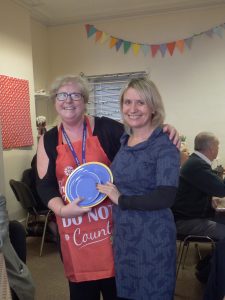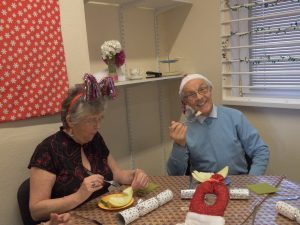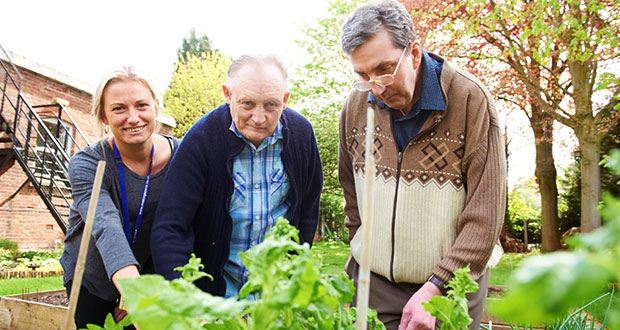Dementia Training By Kathryn Penrith And Rachel Yates, Dementia Space Team, Making Space
There is one fundamental issue to bear in mind when caring for a person with dementia: dementia is a disease. This may seem obvious, but it’s often overlooked. If you see past the disease and don’t let it blind you to the person living with it, the care you deliver will naturally improve.
If you treat someone with a broken leg, you don’t look at the plaster and immediately discount the opinions of that person on the basis that a part of them is broken. You’ll ask questions and assess their needs so you can make them more comfortable. Are they able to walk with crutches, or do they need a chair? Do they need to temporarily adapt their diet because of the lack of mobility? Are they short-tempered because they find it uncomfortable to use the toilet unaided?
With dementia, the symptoms you see are caused by the damage that’s occurring in the brain. Each person with dementia has different damage, wants, needs and abilities. As a carer, what you are confronted with are the symptoms of that damage. You can offer the person with a broken leg a crutch. When caring for a person with dementia, you are that crutch.
Effective communication
Exploring the language we use can help to improve our perception of the disease. One of the common phrases we hear is ‘suffering with dementia’. We want people with dementia to understand that it is possible to live well with the symptoms and that it’s not a catastrophic event: labelling people as ‘sufferers’ immediately gives the person a mental obstacle to overcome. Behaviour is often termed as ‘difficult’, or people are labelled ‘confused’: carers approach them with a pre-conceived notion that there will be a battle to persuade them to eat, or wash, or get into bed.
termed as ‘difficult’, or people are labelled ‘confused’: carers approach them with a pre-conceived notion that there will be a battle to persuade them to eat, or wash, or get into bed.
If someone with dementia is unable to communicate their needs, there may be a neurological or physical issue that is affecting their ability to express themselves. We need to assess each individual’s ability to communicate, work out why they may be becoming distressed and address that issue so that we can make them feel comfortable and safe.
In order to do this, we need to look beyond the diagnosis. The diagnosis is important: we need to know the physiological aspects of the disease. But we also need to look at the whole person and find out about their health needs, their personality needs, their social psychology and their life story.
Documenting life stories is one of the main tools we use at Making Space residential and non-residential services to ensure a high standard of care. This can be anything from one page of A4 to a full book, depending on the person you’re working with and how much information they want to include.
If verbal communication is an issue, try visual aids. It’s a misconception that people in the later stages of dementia can’t communicate: they can, we just need to be creative to ensure they can be understood. Speak to friends, family members or health professionals: anyone who can help you to build up a picture of that person’s life. Include photos, drawings or objects to build their life story, and then use that every day to help you meet their needs. If you know Bob played football when he was younger, you’ll know that’s meaningful to him and how you can support his identity.
Five essential elements for dementia care
The person-centred care of a person with dementia focuses heavily on five essential elements: identity, attachment, comfort, inclusion and occupation.
Every human has the need for an identity, and that need isn’t erased by dementia. Just as Bob’s football is important to him, Alice may have spent a lifetime tending to her garden. Ensuring she’s able to pot some seeds or sit in the fresh air while the grass is being mown, rather than sitting her in a room away from a window, can provide a huge amount of comfort, help her to feel included and allow her to retain her sense of self.
From the moment we’re born, we develop attachments. People with dementia have a significant need to maintain those attachments and this can be as simple as being able to hold or see items that have significant meaning to give them comfort. Taking the time to develop the person’s life story and document it can easily identify what those attachments and items can be.
Occupation is an area which can often be mishandled by those with the best intentions. The old culture of dementia care tended to focus on providing a rigid timetable of task-orientated activities without establishing whether this task was something that the individual may enjoy. For the person with dementia, already dealing with symptoms that are causing distress, being forced into a task they don’t enjoy can be catastrophic.
When it comes to activities, we need to shift our focus from getting everyone together for bingo and instead use the life story to identify something that’s meaningful and achievable. That could be anything from getting dressed independently, to preparing breakfast, to going for a walk.
Challenging the perception of ‘challenging’
 Coercing a person with dementia into an activity they can’t or won’t do can trigger extreme reactions. These reactions are perfectly normal and would be displayed by anyone being forced into doing something that causes distress or discomfort. When you add in the insecurities and discomfort caused by the changes in the brain that occur with dementia, the reactions that are seen as ‘challenging’ suddenly become a lot more understandable. Often, a person with dementia is labelled as challenging or aggressive when perhaps all they really wanted to do was go to the toilet but weren’t being understood.
Coercing a person with dementia into an activity they can’t or won’t do can trigger extreme reactions. These reactions are perfectly normal and would be displayed by anyone being forced into doing something that causes distress or discomfort. When you add in the insecurities and discomfort caused by the changes in the brain that occur with dementia, the reactions that are seen as ‘challenging’ suddenly become a lot more understandable. Often, a person with dementia is labelled as challenging or aggressive when perhaps all they really wanted to do was go to the toilet but weren’t being understood.
If you see a person with dementia becoming distressed or disengaged – staring at the floor, sighing, bracing their arms, tapping – approach them with an open body posture. Be honest – explain that you want to help but don’t understand what they need. Show warmth and compassion and provide comfort: sit with them in silence if necessary, but make sure your body language is non-threatening.
This comes back to the importance of person-centred care and life stories: we need to make sure we understand not only what the person’s abilities are and the stage of their illness, but what gives them comfort and what may lead to more distress. Sitting someone in front of a large Sunday lunch when they’ve just been given medication that makes them feel nauseous, and then loading the plate with a vegetable they’ve never enjoyed, is enough to trigger an extreme reaction in anyone.
The importance of nutrition
If given the choice between eating lunch in a chaotic, loud environment full of clattering pans and a blaring radio, or a calm café atmosphere with beautiful crockery and comfortable furnishings, there are few people who would choose the former.
Providing the right atmosphere, observing individual abilities and respecting preferences can transform mealtimes for the care worker and person with dementia alike.
In practical terms, the damage to the brain caused by dementia can make it very difficult for some people to identify food on the plate or crockery on the table if they’re all similar colours. Mashed potato served on a white plate can be indistinguishable from the white tablecloth.
Instead, choose brightly coloured contrasting crockery and cutlery with coloured handles and ensure the food on the plate is easily distinguishable from its background. Use the life story to identify what the person likes and doesn’t like to eat, and if sitting down for long periods makes them uncomfortable, provide finger food that can be eaten while walking around. Some people with dementia find it difficult to swallow – provide a meal that looks and tastes appetizing, rather than just liquidising whatever’s on the menu. Ask yourself: would you like to eat it?
The consequences of dehydration and a nutritionally-lacking diet are serious: dehydration, dizziness, delirium. This has a knock-on effect on the dementia, which may lead to more distress, increased medication and even admission to hospital. Using personalised care planning to find the right food and the right environment in which to serve it can eliminate these serious consequences.
Practical aids
Alongside person-centred care, there are several aids available to help manage the consequences of dementia and keep the person safe.
Local councils provide a service called Carecall, which includes alarm units that can be worn as necklaces and sensors placed around the home to identify when the person with dementia gets out of bed, or if they try to leave the house.
There are lots of mobile phone apps to help with dementia, including life story apps and cognitive tools. But you don’t need technology – simple signage around the care home or sticky notes to remind them which cupboard holds what help keep people orientated and independent.
Above all, remember dementia is a disease: look past it and see the person, and you’ll go a long way to helping that person to feel safe, comfortable and happy.
Making Space is a national charity providing health and social care services for adults with mental health conditions, learning disabilities and dementia as well as their carers www.makingspace.co.uk

